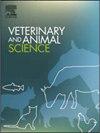Does transport affect the eating quality potential of beef from Limousin cows in France? - A case study
IF 1.9
Q2 AGRICULTURE, DAIRY & ANIMAL SCIENCE
引用次数: 0
Abstract
We hypothesized that transportation might impact beef sensory quality, particularly as the distance between farms and the slaughterhouse increases. Specifically, we expected that pre-slaughter transport over longer distances would induce stress in the cattle, resulting in elevated ultimate pH and, consequently, reduced beef quality. Thus, this study aimed to specifically study the effects of transport in commercial conditions of Limousin cows from farms located in different areas of France to slaughter on ultimate pH (pHu) measured in the Longissimus thoracis muscle (LT), marbling (two major factors affecting eating quality) and the MSA Index (a global indicator of potential eating quality at the carcass level). Cattle were studied according to distance (<50 km; between 50 and 150 km; and between 150 and 250 km from the slaughterhouse) and according to transport time from the farm to the slaughterhouse (divided into short, moderate, and extended). We found that neither distance nor transport time significantly affected pHu of beef and the other studied parameters (cold carcass weight, meat color, MSA Marbling and MSA Index). Consequently, in our commercial conditions, we concluded that the effects of transport on beef carcasses and beef eating quality of Limousin cows are negligible.
运输是否会影响法国利穆赞奶牛牛肉的食用品质?- 案例研究
我们假设,运输可能会影响牛肉的感官质量,特别是随着农场与屠宰场之间距离的增加。具体来说,我们预计屠宰前的长途运输会对牛造成压力,导致最终 pH 值升高,从而降低牛肉质量。因此,本研究旨在专门研究利穆赞奶牛在商业条件下从法国不同地区的农场运往屠宰场对胸长肌(LT)测量的最终 pH 值(pHu)、大理石纹(影响食用品质的两个主要因素)和 MSA 指数(胴体潜在食用品质的总体指标)的影响。根据距离(距离屠宰场 50 公里;距离屠宰场 50 至 150 公里;距离屠宰场 150 至 250 公里)和从农场到屠宰场的运输时间(分为短途、中途和长途)对牛进行了研究。我们发现,距离和运输时间都不会对牛肉的 pH 值和其他研究参数(冷胴体重量、肉色、MSA 马氏花纹和 MSA 指数)产生明显影响。因此,在我们的商业条件下,我们认为运输对利木赞奶牛胴体和牛肉食用品质的影响可以忽略不计。
本文章由计算机程序翻译,如有差异,请以英文原文为准。
求助全文
约1分钟内获得全文
求助全文
来源期刊

Veterinary and Animal Science
Veterinary-Veterinary (all)
CiteScore
3.50
自引率
0.00%
发文量
43
审稿时长
47 days
 求助内容:
求助内容: 应助结果提醒方式:
应助结果提醒方式:


